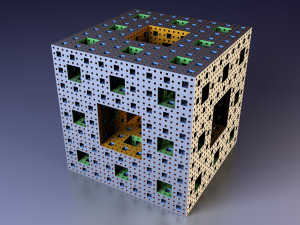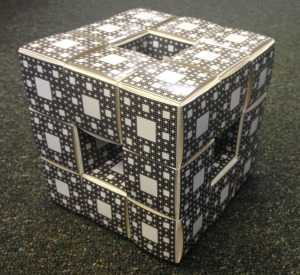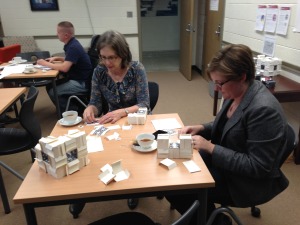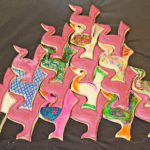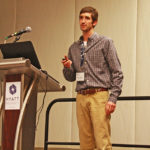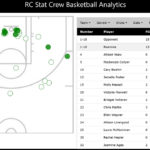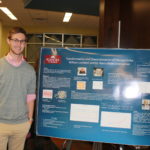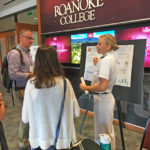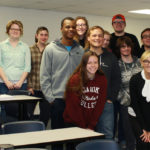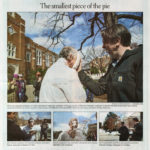Fractals are infinitely complex – infinite and complex are two carefully chosen descriptors. The Menger sponge is one of the classic construction fractals. Start with a cube. On each face draw a Tic-Tac-Toe grid of nine squares, then drill a rectangular tunnel straight through the middle square. Here’s a challenge: you can think of the result as a stack of n cubes whose side length is one-third the length of the original cube. What is n? (Spoiler alert: the answer starts with “tw” and rhymes with “n-t.”)
Like with many fractals, you then apply the same process to each of the smaller cubes, drilling tunnels through the sides of them and producing even smaller cubes. Then drill tunnels through the even smaller cubes, and so on. The final result is something like that shown in the top picture.
The Mega-Menger project is a “distributed fractal” project designed to result in the largest fractal ever built. It will use several million business cards assembled in twenty locations all over the world. The main sponsor in the United States is the Museum of Mathematics in New York City. More information can be found at Michigan, USA build.
The first step in the Mega-Menger construction is to fold six business cards into a cube. Twenty such cubes then get arranged into a larger cube with Menger-like holes. Then twenty of these cubes get arranged into a larger Menger-like sponge, called a “level one” sponge. (See a Roanoke College level one above.) Put twenty level one sponges together to make a level two sponge. (The eight level ones shown below make one side of a level two.) For those keeping score, we’re up to 8000 small cubes and 48000 business cards. Twenty level two sponges make a level three sponge, and the goal is to have twenty level three sponges to make the (level four) Mega-Menger sponge.
That’s a big sponge! And a lot of business cards. And what is the result of this? Ideally, positive interest has been generated about mathematics and its connections to the arts. Perhaps it goes too far to think about thousands of people from around the world doing the same operations before joining talents to form a whole that is more impressive than the sum of its parts. But it’s a nice image, and it’s good that Roanoke College is a part of the picture.
